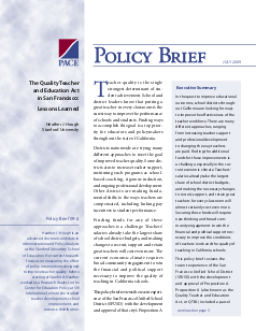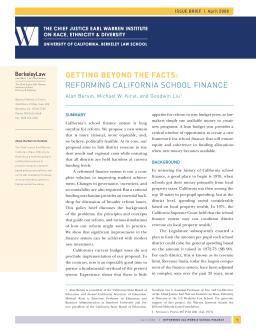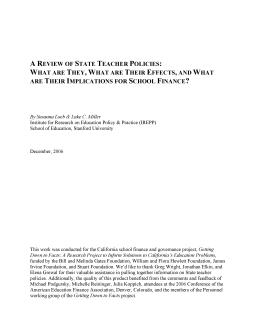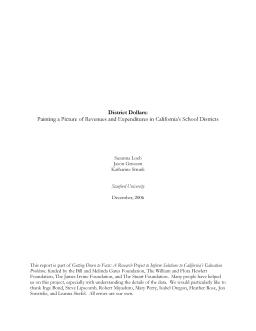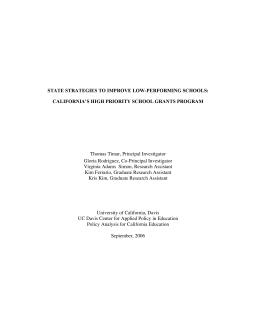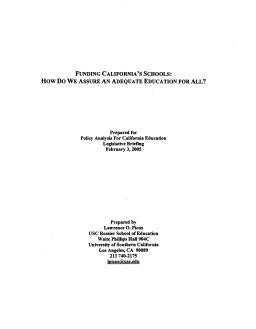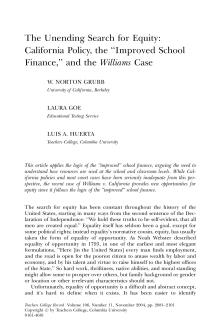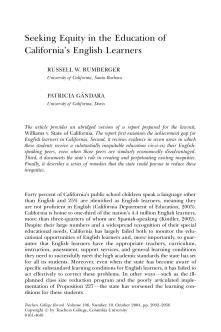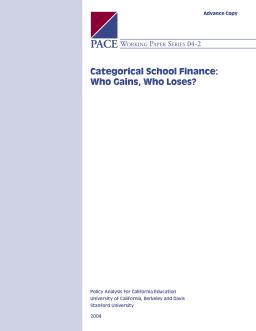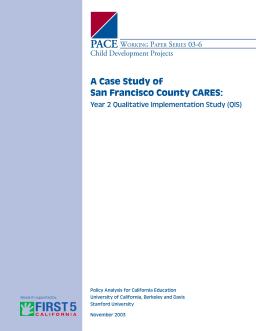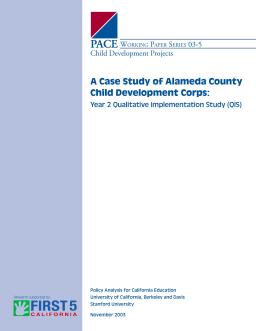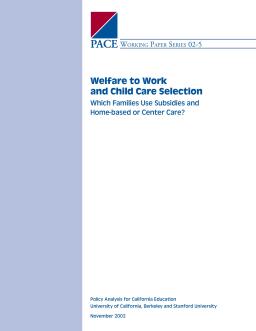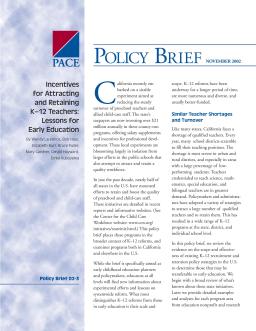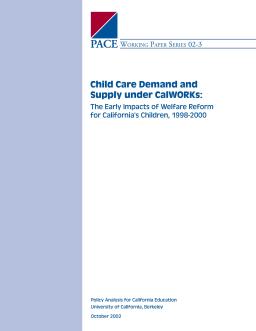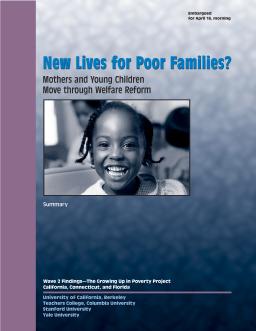Lessons Learned
Published
Summary
This policy brief examines the recent development and approval of Proposition A in the San Francisco Unified School District, which included a parcel tax for increasing teacher salaries, introducing flexibility to the salary schedule, and strengthening accountability for teacher performance. The author describes how the district and union worked together to increase compensation and align school district goals with teacher salaries.
The Quality Teacher and Education Act in San Francisco
Published
Summary
This policy report reviews the approval of Proposition A, a parcel tax initiative in the San Francisco Unified School District, which aimed to improve teacher salaries and fund innovative compensation programs. The report includes an assessment of the programs funded by the tax revenues, and is based on interviews and public documents.
Investing in Education Facilities and Stronger Communities
Published
Summary
California is midway through one of the grandest public infrastructure projects ever attempted. Over the coming decade school officials will complete an $82 billion effort, building new schools and renovating old facilities, supported by taxpayers and private investors. But are state officials and local planners building schools mindfully to advance educational quality and lift local communities?
School Finance and Governance in California
Published
Summary
Getting Down to Facts is an extensive investigation of CA's public education system commissioned by a bipartisan group of CA leaders. The project aimed to describe California's school finance and governance systems, identify obstacles hindering resource utilization, and estimate costs to achieve student outcome goals. The project resulted in 23 reports by scholars, which highlight that the current school finance and governance systems fail to help students achieve state performance goals, particularly those from low-income families. The reports provide a framework for assessing reform options.
Reforming California School Finance
Published
Summary
This policy brief proposes a more rational and equitable school finance system for California that links district revenue to student needs and regional costs. The proposal aims to ensure that all districts are held harmless at current funding levels while providing essential backdrop for broader reform issues. The brief discusses the problems with the current finance system, the principles and concepts that guide the reform, and simulations of how it might work in practice. The report shows that significant improvement in the finance system can be achieved with modest new investment.
Preschool and K–12 Finance Reform in New Jersey and Texas
Published
Summary
This report examines factors that affect student achievement in California schools, finding that family background and school context are important determinants. The report recommends that schools focus on providing high-quality instruction, improving reading and math skills, and creating a positive school climate. Policymakers should increase resources for under-resourced schools and promote parental involvement. Continued research is needed to better understand the complex factors that shape student outcomes.
Published
Summary
This report focuses on estimating the costs for California school districts to meet state-set achievement goals and how these costs differ across districts with different student characteristics. The study uses an econometric cost function approach to estimate base costs and marginal costs associated with poverty, English learners, and special education. The findings are compared with cost studies in other states and used to analyze whether the current school finance system appropriately accounts for cost differentials across districts.
What Are Their Effects, and What Are Their Implications for School Finance?
Published
Summary
The report explores the impact of teacher sorting, or the tendency for high-achieving students to be assigned to more effective teachers, on student achievement. It finds that teacher sorting has a significant positive effect on student achievement in both math and English language arts. The effects are particularly strong for students who start out low-achieving. The report argues that policies aimed at reducing teacher sorting, such as random assignment of students to teachers, may be counterproductive for student achievement.
Painting a Picture of Revenues and Expenditures in California’s School Districts
Published
Summary
The report explores the relationship between teacher experience, school characteristics, and student achievement. Teacher experience is positively associated with student achievement, particularly in schools with high concentrations of low-income students. Additionally, the authors find that school size, teacher turnover, and teacher qualifications also impact student achievement. The report concludes that policies aimed at improving teacher quality and experience can have positive effects on student outcomes, particularly in high-poverty schools.
California's High Priority School Grants Program
Published
Summary
The report examines the effectiveness of a large-scale performance-based incentive program in California schools. Results show that the program had a small but positive impact on student test scores in math and English, with larger effects in schools with high levels of poverty. However, the authors caution that incentive programs may have unintended consequences and should be implemented with care.
Spinning Out the Implications of the Improved School Finance
Published
Summary
Despite the belief that increased spending leads to better educational outcomes, real expenditures per pupil have doubled since the late 1960s, yet problems in schools persist. An improved school finance approach focuses on effective resources in schools and classrooms that improve valued outcomes, rather than just increasing spending. Clarifying why funding is often wasted and developing new models of connections between revenues, resources, and the results of schooling is essential.
How Do We Assure an Adequate Education for All?
Published
Summary
California ranks 44th in the nation in education spending, spending only 86.1% of the national average per pupil in 2001-02. The recession of the early 2000s resulted in dramatic budget deficits for the state and substantial reductions to the expected level of school funding. Research suggests using the concept of adequacy to estimate the costs of providing an educational program that will enable all—or almost all—children to meet the state's high proficiency standards and offers recommendations for finding additional resources needed to adequately fund California's schools.
California Policy, the "Improved School Finance," and the Williams Case
Published
Summary
This article applies the logic of the ‘‘improved’’ school finance, arguing the need to understand how resources are used at the school and classroom levels. While California policies and most court cases have been seriously inadequate from this perspective, the recent case of Williams v. California provides new opportunities for equity since it follows the logic of the ‘‘improved’’ school finance.
Published
Summary
This article presents a summary of a report prepared for the Williams v. State of California lawsuit, highlighting the achievement gap for English learners in California and seven areas where they receive an inequitable education compared to their English-speaking peers. It also documents the state's role in perpetuating these inequities and proposes remedies to reduce them.
Who Gains, Who Loses?
Published
Summary
Over the past 30 years, a combination of court rulings, legislative enactments, and voter initiatives has made dramatic changes in the landscape of education governance in California. The presumption of local control, a system based on local electoral accountability, has been superseded by a system of centralized, administrative accountability. Among the most sweeping changes are those that affect the way in which the state’s public schools are financed. Until 1980, paying for elementary and secondary education was largely a local matter. Local property taxes paid most of the bills. The state...
Year 2 Qualitative Implementation Study (QIS)
Published
Summary
This paper assesses the perspectives and experiences of stakeholders on San Francisco County’s CARES program, a childcare retention–incentive program. Year 2 saw over a threefold increase in the number of stipends awarded, but recipients felt the program couldn't address ECE staff retention/turnover alone. Solutions need to be implemented within a larger system of support, raising public awareness, expanding professional development opportunities, and exerting pressure on policymakers for sustained funding to augment ECE staff salaries.
Year 2 Qualitative Implementation Study (QIS)
Published
Summary
This paper discusses the second year of Alameda County’s Child Development Corps program as a childcare retention-incentive program. The program's goals were to encourage staff training, professional development, and establish a strong network of ECE professionals. Stipend recipients were pleased with the program but recognized that it could not function alone in addressing staff retention, and a larger system of support and advocacy was necessary.
Which Families to Serve First? Who Will Respond?
Published
Summary
This paper discusses extending access to preschool for families in California, focusing on targeting priorities to yield strong enrollment demand and discernible effects on young children's early development and school readiness. It analyzes different targeting mechanisms and suggests experimenting with alternative expansion strategies, rather than investing exclusively in one method. The report also describes which communities would benefit most and considers the criteria for judging the wisdom of targeting options.
Which Families Use Subsidies and Home-Based or Center Care?
Published
Summary
Public spending on childcare has increased, but low-income families still face barriers to accessing subsidies. This working paper examines the choices made by 1,974 parents in California who moved from welfare to work and needed childcare. The study found that parents relied on a mix of formal and informal childcare options, and that the expansion of one form of care did not necessarily influence parents' choices.
Lessons for Early Education
Published
Summary
This policy brief discusses state initiatives in the US aimed at retaining and improving the quality of preschool and childcare staff, with a focus on California's $21 million annual investment. While K-12 reforms have been underway longer and are usually better-funded, early childhood education policymakers and educators will find valuable information about experimental efforts and lessons on systemwide reform.
The Early Impacts of Welfare Reform for California's Children, 1998–2000
Published
Summary
This report examines the effects of welfare-to-work and childcare capacity building on the childcare system in California, prompted by changes in the childcare system and welfare reform. The study was requested by the California Department of Social Services, and this paper provides an overview of the findings.
California Families See Little Growth in Child Care Centers
Published
Summary
The rise in the number of working mothers has led to a greater need for childcare, and investments have been made to support early education. California's childcare programs have seen a surge in funding, including a tax credit program. The policy brief aims to explore if the increased funding has improved access to quality childcare centers and preschools for California families.
Mothers and Young Children Move Through Welfare Reform
Published
Summary
This report discusses the lack of knowledge about the impact of welfare-to-work programs on young children since 1996, and how policy leaders are debating ways to aid jobless mothers and enrich their children's lives. The project team followed 948 mothers and preschool-age children for two to four years after the women entered new welfare programs in California, Connecticut, and Florida.
Mothers and Young Children Move Through Welfare Reform: Executive Summary
Published
Summary
This report examines how welfare-to-work programs have affected the lives of young children since 1996, and how they've impacted the home and childcare settings in which they are raised. The study followed 948 mothers and preschool-age children in California, Connecticut, and Florida for two to four years, using interviews, assessments, and visits to homes and childcare settings. The report highlights the major findings from the study.
Published
Summary
This article discusses the role of childcare in promoting the development and opportunities for low-income children, noting that federal and state funding for childcare has increased dramatically since welfare reform. Despite this, children from poor households are less likely to be enrolled in high-quality programs than children from affluent families. To achieve welfare reform's goal of breaking the cycle of intergenerational poverty, welfare-to-work programs should increase access to high-quality childcare in low-income neighborhoods.
